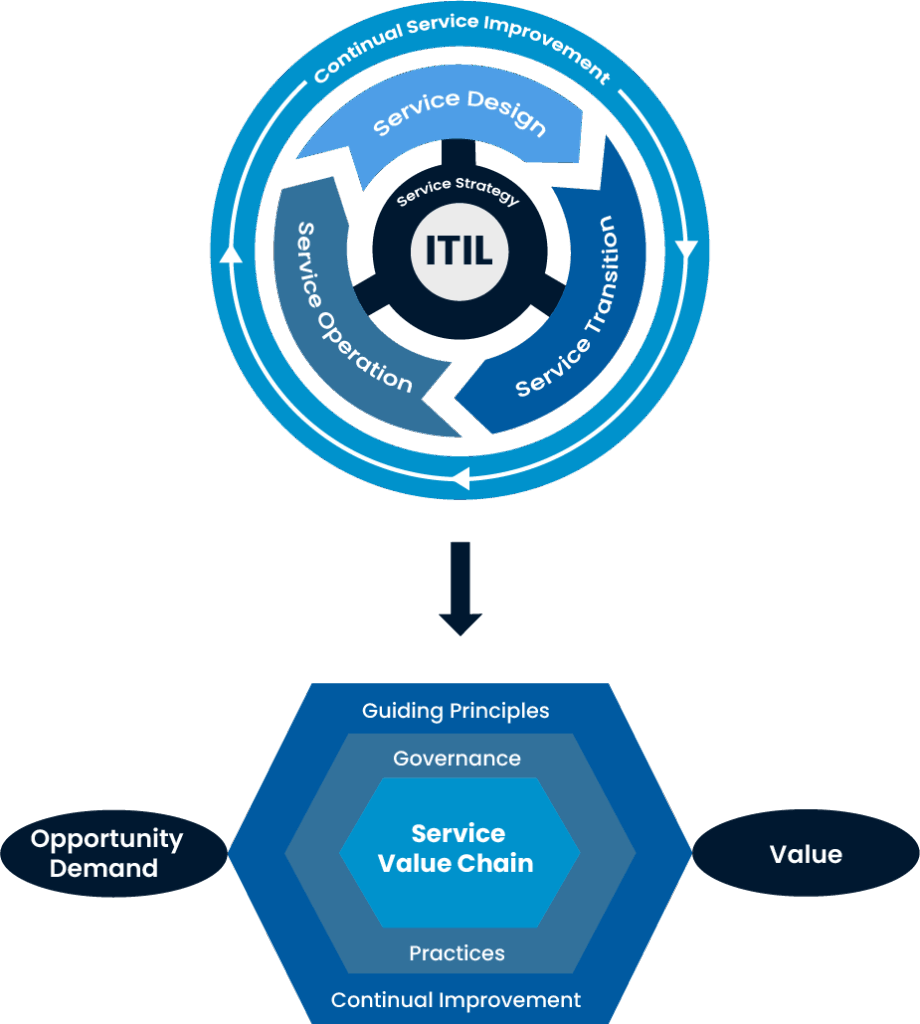
ITIL and ITSM are two substantial approaches for experts seeking efficiency and sustainability in IT service management. In this framework, ITIL (Information Technology Infrastructure Library), which is used to effectively implement ITSM, is a framework developed to manage IT services in the most efficient way. ITIL is a set of best practices developed for IT service management (ITSM).
In other words, ITIL describes step by step how a company should go about planning, delivering, managing and improving its IT services.
ITIL is not a software or a tool – it is a “guide”.
It serves a single purpose: To make IT better serve business goals.
Today, the frequently asked question of what is ITIL 4 defines the most up-to-date and agile version of this structure, reconfigured according to the needs of the digital age. ITIL, like all other processes in IT, has undergone changes over the years. ITIL 4, released in 2019, is the most current version of the ITIL metadology.
As the need for IT teams to produce more efficient, cost-effective and customer-oriented solutions increases in an environment where technology is changing rapidly; ITIL 4 ensures that IT operations are carried out in a more controlled, transparent and sustainable manner.

How ITIL 4 Creates a Value For Organizations?
ITIL 4, makes IT service management more strategic and compatible. Launched in early 2019, this updated framework has contributed to the creation of an effective IT Service Management process, providing an end-to-end operating model for the creation, delivery and continuous improvement of technology-enabled products and services. At this point, the answer to the question of what ITIL 4 is is not only a methodology, but also a structure that enables companies to provide services in a more agile and compliant way in a rapidly changing digital world.
Today, companies must not only provide services, but also respond flexibly and quickly to ever-changing business needs. ITIL 4 was developed in response to these needs and provides practical solutions to the complexities and challenges of the modern IT environment. For example, a financial institution can reduce service disruptions by adopting ITIL 4 because ITIL 4’s proactive change management approach helps identify potential problems in advance. This enables organizations to experience less downtime and maintain service continuity more effectively. At the same time, companies can perform more effective process transitions and increase operational efficiency.
The Role of ITIL 4 in Digitalizing Business
The answer to the question, what is ITIL 4, is not just a framework; it is also a powerful guide to improve quality and optimize processes in service lifecycle management. This contributes significantly to improving business processes. Here are some of those;
Digital Transformation and Innovation:
ITIL 4 guides the integration of business processes with modern technologies (such as cloud, artificial intelligence, automation) by supporting organizations’ digital transformation processes. This approach makes processes more agile and efficient.
To support this transformation, we are making software development accessible to everyone with Cheetah Low-code Platform, which eliminates the need to write code. With
Cheetah, in-house teams can quickly develop applications and easily manage maintenance and updates without the need for outsourcing.
“Continual Improvement” and ‘Service Value Chain’ are important concepts in ITIL 4. Cheetah Low-code Development Platform quickly models IT service processes (incident management, change management, service request management, etc.) and makes them operational. This greatly accelerates the continuous improvement cycle.
At the same time, the ITIL-based IT Service Management (ITSM) solution we developed for the digitalization of external customer services and internal IT processes enables transparent management of support requests, monitoring of breakdown and installation processes, and automation of internal operations. In this way, both customer satisfaction and employee experience are significantly improved.
Risk Management and Security:
ITIL 4 makes risk management a natural part of business processes. It encourages early detection, analysis and control of risks within your operations. It also ensures that data, services and processes are protected through security practices. This approach reduces service interruptions and strengthens business continuity.
Value Chain and Service Management:
ITIL 4 relates each step to the planning, designing, developing, delivering and improving processes with the Service Value Chain model. In other words, it understands how an organization uses resources and generates value. This creates a clear flow and division of responsibility between business processes. By supporting different departments and processes to work together, it accelerates service production, improves quality and enables the organization to achieve its goals in a more organized way.
As can be seen from the three points above, the question of what ITIL 4 is, goes beyond a framework, but also raises the question of how to integrate modern IT processes with ITSM more efficiently.

How Critical is ITIL Sertification for Efficieny in Business Processes?
The design and present of digital services should not only be driven by setting objectives, but also by identifying in advance potential problems that may be encountered during the development, delivery and maintenance processes.
ITIL manages this process comprehensively, covering the entire lifecycle from requirements definition to solution design, continuous review and improvement, and service maintenance. Integrating ITIL into systems offers significant advantages to businesses. One of the most important benefits is that it reduces time and cost waste in the development process, while at the same time improving the quality of the final product. As a result, customer satisfaction and employee motivation increase once the service is implemented.
As a result, obtaining ITIL 4 certification can be seen as a critical step for organizations’ sustainable growth and operational excellence.




